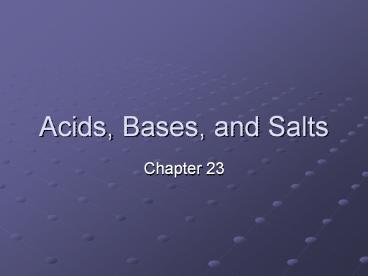Acids, Bases, and Salts - PowerPoint PPT Presentation
1 / 24
Title: Acids, Bases, and Salts
1
Acids, Bases, and Salts
- Chapter 23
2
Acids and Bases Section 1
- What do you think of when you hear acid?
- Acids have at least ____ hydrogen atom that can
be removed - Acid produces ______ in a water solution.
- H reacts w/ H2O to form H3O ?
____________________ ion
3
Properties of Acids
- Taste _______________
- ____________ on skin
- Corrosive irreparable _____________
- React strongly w/ certain metals and produce H2
___________ - React w/ indicators to produce different
_____________ - _________________ organic compound that changes
color in an acid or base.
4
Common Acids
5
Bases
- Ex ____________ powder, Mallox and antacids are
bases - ______________ clean greasy, fatty substances
(bases) - Base produce hydroxide ion,________, in H2O
solution. Also, accepts H ion.
6
Properties of Bases
- _____________ of acids
- Many are crystalline ____________
- Most are _____________ compounds
- Feel ___________ and have bitter taste
- Corrosive and cause severe _________
- React w/ ________________ to produce different
colors
7
Common Bases
8
Strengths of Acids and Bases
- Section 2
9
Strong and Weak Acids
- Strength depend on how many _______________
dissociate into ions - Strong Acid nearly _________ molecules
dissociate into ions - Ex HCl, __________ , H2SO4
10
Strong and Weak Acids
- Weak Acids only _________ amount dissolves in
water - ________ do the damage more ions more
_____________!! - Ex Acetic Acid and _____________ Acid
11
Strong and Weak Acids
12
Strong vs. Weak
- Strong ?
- All _________________
- Weak ?
- Some __________________ and Some Products
13
Strong and Weak Bases
- Most ___________ are ionic compounds
- Strong Base dissociate _____________ to its
ions. Ex sodium hydroxide, NaOH - Weak Base does __________ dissociate completely.
Ex ammonia, NH3
14
Dilute and Concentration
- Dilute more ____________ than acid
- Concentrated more ___________ than water
- Can have concentrated ________ acid and
_____________ strong acid
15
Measuring Strength
- pH measure of concentration of _____
- More H the _____________ the pH
- Scale from 0 14
- 7 __________, concentration of OH-
concentration of ________ - Below 7 _____________, more H
- Above 7 _____________, more OH-
16
pH Scale
17
Buffers
- Def solutions containing __________ that react
with additional acids or bases to
_________________ effects on pH
18
Salts
- Section 3
19
Neutralization
- Def rxn between an ____________ and a
______________ that takes place in a water
solution. - 2 rxns occur HCl(aq) NaOH(aq)
- H3O(aq) OH-(aq) ? H2O(l) ________
- Na(aq) Cl-(aq) ? NaCl(aq) ________
20
Salt Formation
- _____________ compound formed when (-) ion from
combines with __________ ion from base - Ex NaCl
21
Acid Base Rxns
- acid _______ ? salt ________
- 2HCl(aq) Ca(OH)2(aq) ? CaCl2(aq) 2H2O(l)
22
Soaps and Detergents
- ___________(water) and Nonpolar(grease fat)
substances - Like dissolves Like
- Polar dissolves Polar, etc.
- Soaps have both Polar and _________ ends
- Mix with water and grease
- Hydrocarbon Chain is 12 - _____ carbons
23
(No Transcript)
24
Soap Scum
- Salts form that are ______________ in water
- _________________ do NOT make insoluble salts
- can be used in cold water































